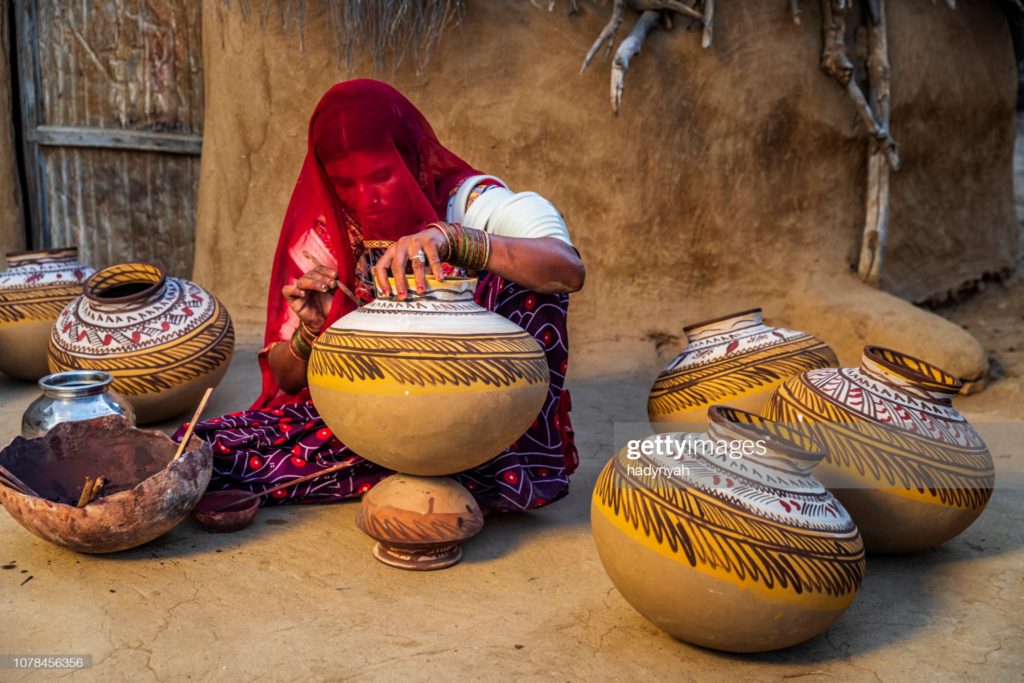
“ Ab mujhe apne pati ka sunna nahi padta, kyuki main khud ka paisa kamati hu, aur ghar chalati hu (I don’t have to bear the temper of my husband anymore. I run my household with my own salary)”, says Rita, my house-help who also makes handicraft goods and earns money by weaving baskets from her home. Similarly, Rita’s neighbour Ganga Devi is involved in pottery making and also makes diyas whenever Diwali is round the corner. The smile on Rita’s face, the undertone of pride in her voice is the magic of handicraft industry that has opened doors for women to break the chain of oppression and restrictions.
Everybody wants financial independence because that leads to social and psychological well-being. To your horror, in a statement by the International Labour Organisation in 2018, the global labour force participation for women was close to 49% while for men, it was 75%. The gender gap is the reality of the globalised society which boasts about its liberalisation and privatisation.
Finding a job is a million times harder for women. In case they find it, those are jobs in vulnerable conditions where there lies no scope of improvement or personal growth, while men flourish in coveted white-collar jobs. The pay gap is also very stark. A man gets paid higher solely because he is a ‘he’ while a woman, no matter how talented and promising she is, gets a lesser wage. Maybe because the society’s perception resonates with the Aristotelian view of gender in which he very conveniently upholds that women lack deliberative capacity, thus unfit for work. The freedom to work, the freedom to choose where to work, the freedom to demand a safe and dignified environment at the workplace are basic human welfare rights. Until and unless the society removes a woman from the category of being human, there lies no valid reason to deprive them of basic rights.
Social equality refers to a state where everybody is treated fairly and given equal opportunities without any discrimination. However, a patriarchal society is an antithesis to equality. This is a major impediment for a woman’s growth. Moreover, the strict, irrational sexual division of labour that dictates gender roles has chained women depriving them of freedom to work. Owing to such roles and stereotypes it becomes a tedious task to manage the workload. The societal concept of motherhood often puts a mother at a crossroad while making a decision about her career. Another major issue is the concern for safety and the fear of sexual harassment. Lack of accessible transport often refrains women and their families from deciding about being able to work outside.
The prevailing stereotype that a woman is incapable of being technologically advanced also creates a blur while recruiting women in machine-made industries. According to the World Economic Forum 2019 Report, there remains a perception among 52% of women that technology is a male industry, while almost a third (32%) believe gender bias is still a major hurdle in the recruitment process. There is a deficiency in training women in technological skills because this is ‘considered’ to be a domain dominated by men (85%). Technology is advancing and reaching new heights while achieving gender parity seems like an uphill struggle. With Artificial Intelligence infiltrating industries, achieving social equality seems like a distant dream. The Forum’s gender gap report findings indicate that women represent just 22% of the AI workforce.
HANDICRAFT INDUSTRY AT RESCUE:

The handicraft industries bring us one step closer to the world of social equality. It is known for its freedom, self-reliance and motivation. All types of handicraft work ranging from craft to basket weaving to embroidering etc. helps us overcome a few barriers that stand between our world and the world of social equality. It provides the freedom to work whenever you want. There is no sand running, no nine to five obligation. Employment through crafts helps to obliterate the sense of frustration and lack of human dignity that comes with unemployment and baggage of imposed social stigma. In a world where caste and gender dictate the kind of work one is allowed to do, there is no room for dignity. But handicrafts provide a level playing field for all the victims of social inequality. This boosts confidence and creates a sense of identity, pride and self-awareness which is one step-up the ladder of social equality. One begins to use their talents to earn by themselves. This further opens door for them to become financially independent. This allows them to live with dignity, and the freedom to choose who they want to live with. The fear of being left unfed post divorce from a torturing husband doesn’t haunt them. They contribute to the family economy and no more live a life of insecure, economically deprived individuals. It helps them run the household as heads, gives them a voice and leads to their personal growth. There is no room for reasons like “You’re not safe. Don’t travel alone. Don’t work till night.” This is one chain broken from the shackles of prescribed gender roles. The flexible nature of handicraft work allows them to undertake their home and childcare responsibilities while providing income which they can control. Slowly and gradually, they can smash patriarchy once and for all.
According to the Indian handicraft census, 56.13% of artisans are women.
Some of the examples that shows how women are on a better pedestal when it comes to handicraft work:
1. Kumaoni weavers:

Women weavers from Kumaon valley are gaining prominence on the global map of crafts and heritage for spinning looms, weaving and in some cases dyeing the fabrics in beautiful colours for a more palatable, urban appeal. Because of the weather conditions, blankets, quilts, shawls, silk stoles, and mufflers are their primary produce.
2. Exquisite ‘Lambani’ craft from Karnataka:
Rural women of the Lambani tribe from Bellary in Karnataka have benefited manifold with the Geographical Indication status granted to the art form in 2010. The Lambani embroidery is a combination of mirror work, stitching, pattern, and appliqué work done on dark coloured fabrics such as red, green, blue, and black. The cloth is made of cotton khadi dyed with chemical or vegetable dyes made from Rathanjot, Kattha, Chawal Kudi, Pomegranate peel, etc. There are 14 types of stitches used in Lambani embroidery. They are known to use shells and coins as well.

Handicraft industry is not a safe haven unhaunted by the ills of the society. However, it strives to create a world where one has the realistic means to fight against the societal evils. Talking about creating an equal world looks beautiful only when uttered through those lips, its value is nothing if it’s not applied. Handicraft industry not only talks about social equality, but helps in achieving it. Its benefits are social and psychological. Due to the creative and flexible nature of craftwork a variety of personal benefits can be derived from the sector including a sense of identity, self-reliance, self-awareness, empowerment, confidence, respect and cultural self-esteem. It elevates the status of those who are despised and unfairly treated by the mechanised industries like person with disability, women, lower caste, and tribal. Handicraft industry helps create an atmosphere of equality by bringing a social change in the structure of a family. Gainful employment for society’s members can contribute to social stability. Geographical decentralisation of income opportunities helps to reduce rural exodus and the many associated social problems which can in turn reinforce family cohesion and stability. Thus, an individual flourishes, the society progresses and the nation develops.
Content writer Aastha tiwari is a girl who is stating at the clouds from the window sill listening to Surjan Stevens while contemplating the metaphorical undertones coloring the cloud. Role: Content Writer.Educational Qualification: Second year Political science major.Ultimate Goal: UPSC.Biggest achievement: Being featured as the writer of the month for Feminism In India.


